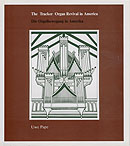
Rezension zu
 The Tracker Organ Revival in America
The Tracker Organ Revival in America
in The American Organist, Mai 1979, S. 21-22
In its May 1940 issue The Diapason printed a rather sharply worded editorial, entitled 'Advancing Backward'. The piece was in response to a letter from the late Gilman Chase, advocating a return to tracker key action. Between that issue and the following September's, when a halt was finally called to discussion of the topic, much ink was spilled pro and con and the journal's, editors discovered, to their obvious dismay, that Chase was not alone in entertaining seditious thoughts against the all-beneficent magnet-and-pneumatic.
During the next few years, many young American organist-soldiers had the opportunity to experience old European Instruments first hand. Their artistic merit, the satisfaction playing them imparted, and their longevity all combined to bring about a nagging suspicion, and then a firm conclusion, that America's technological prowess had led organ building down a deadend path, and that its direction would have to be reversed.
Dr. Pape's book is a chronicle in words and pictures of that reversal as it progressed through 1977. The volume is beautifully produced with a whole section - 142 pages - of organ photographs, in addition to those scattered generously throughout the other sections. This portfolio of black-and-white plates, printed on high-quality paper, is by itself worth the price of the book; however, it is but one part.
There are opus lists of American builders and lists of organs by European builders for American clients. Eighty-four pages of stoplists illustrate the work of a wide variety of builders European and American.
The book opens with a set of articl, each of them in both German and English, by Fesperman, Biggs, Pape, Redman, Glatter-Götz, Fisk, Bozeman, Laufman, Louder and Wolf, covering areas from the beginnings of the revival (Fesperman), to a perceptive and thought-provoking essay on future trends (Louder and Woiff). There is, however, a degree of unevenness in the set.
Fisk's espousal of flexible winding is both reasoned and persuasive; but one must question the appropriateness of reprinting in such a context a decade-old Journal article, important though it was, rather than a current exploration of the topic and recent developments in winding, preferably by the same author.
Similarly, while Glatter-Götz's saga of the ill-fated Rieger Positiv venture of the 1950s makes for interesting reading, his analysis of the differences between the European and American tracker organ revivals bears scrutiny in its particulars. The piece as a whole verges dangerously close at times to becoming a harangue.
Finally, the influence of nineteenth-century American organ building on late twentieth - if for no reason save the examples that have survived - is scarcely alluded to, except for a paragraph in the Bozeman-Laufman article.
Taken in sum, however, the flaws cited pale to insignificance beside the magnitude of the project undertaken, and the distinctiveness of the result. In fact, the importance of this volume almost mandates that it be kept current, and it is ardently to be hoped that Dr. Pape will publish regular periodic supplements.
In sum and put simply, no library of literature on the organ, institutional or private, can afford the luxury of being without this book; nor should any organist or organ lover deny himself or herself the sheer pleasure of turning its pages reveling in its sumptuous photographs and exploring the vast store of information to be found between its covers.
John Ogasapian
Rezension zu
 The Tracker Organ Revival in America
The Tracker Organ Revival in America
in The Tracker, 1979, Heft 3, S. 23.
Here is a most important publication for all who are concerned with history-in-the-making, made all the more interesting by the fact that its author is essentially an 'outside observer', a European - and Europeans are traditionally not supposed to concern themselves with goings-on in 'the colonies'. Well, history is being made here, and Dr. Pape, well-known as a historian in his native Germany, is but one of many who are taking notice - and certainly, as this book proves, one of the most articulate.
Published in both English and German, and with dual prefaces by Hermann Busch and E. A. Boadway, the book consists of six parts. Part l comprises articles by both Americans and Germans, some reprinted from other sources. Authors include John Fesperman, E. Power Biggs, C. B. Fisk, George Bozeman, and Alan Laufman, to mention some who also happen to be OHS members. Part II is a list of American installations by European builders, and Part III the opus lists of American and Canadian builders of tracker action organs. The lists of Parts II and III are unusually exhaustive and complete, the only flaw being the inclusion of some rebuilt instruments in the lists of some American builders, for which Dr. Pape can hardly be faulted, since he requested only new installations and a complete checking out of the lists would have been impossible even for an American. Part IV consists of representative specifications, and part V of photographs of organs. Part VI is an appendix in which are contained biographies (and pictures) of organ builders, references, lists of societies and journals, and builders themselves, and include in some instances employees in some of the American firms.
What we have in this book, then, is a documentation, essentially, of where we are and, to some extent, how we got there, as of A.D. 1978. Put together in a tastefui, scholarly, and well-organized manner, l predict that this volume will very speedily become an indispensible source- book on the history and development of the American organ in the second half of the twentieth Century.
Barbara Owen
 Seitenanfang
Seitenanfang